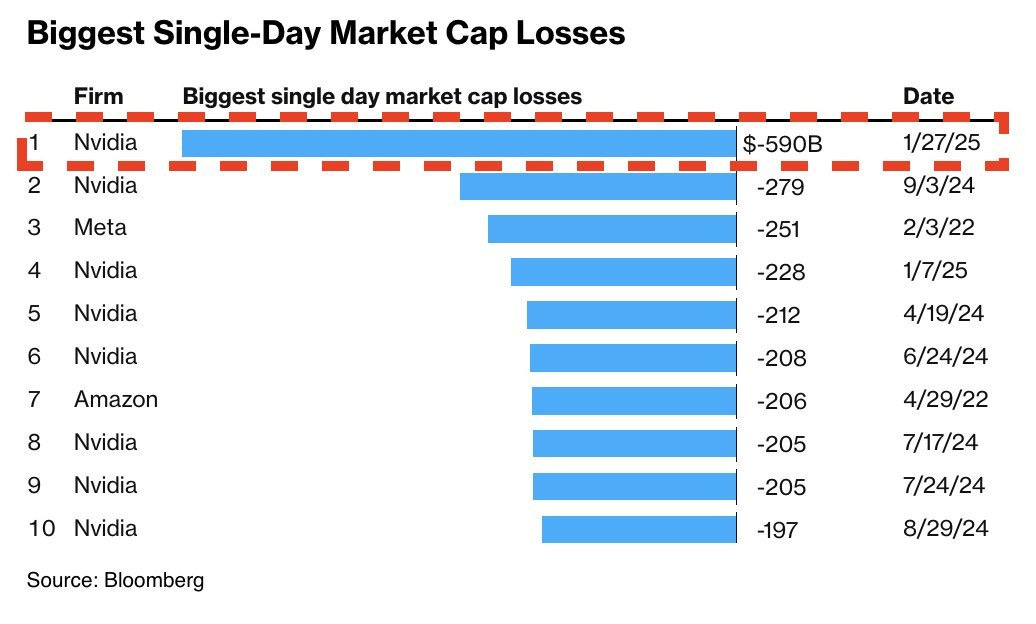Before we get started, I wanted to let you know the new episode of my podcast Room to Run is live on Spotify and Apple Podcasts.
In this week’s episode we discussed:
My updated outlook on US markets in light of DeepSeek and Trump’s tariffs
The Magnificent 7 stock that’s a clear buy after earnings
My reaction to last week’s Federal Reserve meeting
Preview of next week’s market moving events
Each 10-minute episode can be listened to for FREE on Spotify and Apple Podcasts. If you enjoy the podcast, please leave a review.
Even the strongest bull markets at times face turbulence.
And we’re in one of those times now.
The past two weeks have delivered a double shock to financial markets—one from China’s AI sector with the release of DeepSeek R1, the other from Trump’s unexpected tariff escalation. Either one of these stories alone would be enough to move markets.
But together? They’ve triggered one of the most volatile trading stretches we’ve seen in years.
So, what does this mean for investors? And more importantly, what does this tell us about how markets will react to the latest tariffs on Canada, Mexico, and China?
Let’s break it down.
The Biggest Stock Drop in History
Last Monday, we saw a sell-off that raised a lot of eyebrows. Not because the entire market collapsed—but because it didn’t. Instead, we witnessed a highly unusual event: a targeted correction that wiped nearly $600 billion off the market cap of a single stock: Nvidia (NVDA).
The numbers from last Monday were staggering: Nvidia’s stock plunged 17%, erasing $590 billion in market cap. To put that in perspective, there are only 12 companies in the entire world with a total market cap greater than $590 billion.
And yet, something strange happened.
Rather than a broad market meltdown—like we saw last August during the yen carry trade panic—the selling was mostly contained to AI hardware stocks. Nvidia (NVDA), Taiwan Semiconductor (TSM), Broadcom (AVGO), and other chip-related names took the hit, while the rest of the market held steady.
In fact, many value stocks rallied on the day. Financials closed at all-time highs. Defensive plays like Berkshire Hathaway (BRK.B), Waste Management (WM), and Costco (COST) surged.
This tells me one thing: The broader bull market is still alive and well.
And that’s more important to remember now than ever as President Trump’s ill-advised tariffs are implemented.
Another Chapter in the “Wall of Worry”
I was a bit freaked out by the DeepSeek news when I first read about it.
I spent all day on Sunday trying to understand the situation as well as possible so I could show our over 1,000 TikStocks Portfolio members how I would adjust my portfolio in light of this news.
But the more I understood the situation, the more I realized this was a temporary hit to the AI bull market’s narrative and not a major sea change as I first expected.
I also reminded myself that there are always things to worry about in the markets. Fund manager Peter Lynch often called this the “Wall of Worry”:
And now we have a new chapter in the ever-expanding “Wall of Worry”: Trump’s tariffs.
Tariffs, So Hot Right Now
I’ll be the first to admit—I didn’t expect Trump 2.0 to actually implement broad tariffs on key trading partners. I assumed they’d be a negotiation tactic. That was wrong.
Trump slapped 25% tariffs on all goods from Canada & Mexico and added a 10% tariff on imports from China—a move that caught many investors off guard.
Here’s what this means for markets:
Higher Input Costs → Tariffs drive up the price of imported goods, potentially leading to an inflation spike. That could delay Fed rate cuts—or even increase the odds of further hikes—which is bad for equity valuations.
Lower Consumer Spending → Higher prices on goods like cars and appliances could hit retailers ($WMT, $TGT) and home improvement stocks ($HD, $LOW) as consumers pull back.
Higher Oil Prices → Canada is the largest oil exporter to the U.S.. Energy stocks ($XOM, $CVX, $OXY) benefit, but transport-heavy industries (airlines, trucking) will feel the squeeze.
More Market Volatility → We already expected choppiness in 2025, but these tariffs add another layer of uncertainty.
Even companies that aren’t directly affected—like Microsoft (MSFT), Alphabet (GOOGL), Amazon (AMZN), and Apple (AAPL)—could face increased component costs due to global supply chain disruptions. That means the S&P 500 (SPY) and Nasdaq (QQQ) could see near-term selling pressure.
And while estimates vary, some show that the tariffs act as a “hidden tax” on investors of as much as $1,200 per household. That will be a potential headwind for US consumers.
That said, I expect this volatility to be shortlived and a gift to savvy investors.
A Repeat of the 2013 Taper Tantrum?
The “Trump tariffs” remind me of the 2013 Taper Tantrum—a moment when the market initially panicked over Fed tightening before eventually stabilizing.
Back then, the market overreacted to the idea of higher interest rates, only for investor pressure to force a policy shift that helped extend the bull market.
I believe something similar will play out with tariffs. Trump has always been transactional—he watches the stock market closely, and when investor backlash builds, I expect him to scale back these tariffs in response. He also has a history of creating chaotic situations (e.g. China Trade War in 2018, North Korean Nuclear Crisis, multiple government shutdowns, etc.) only to come in and “fix” the problem later on.
But in the meantime, there will be more market volatility, which I view as an incredible buying opportunity.
That’s why in tomorrow’s TikStocks Portfolio update, I’ll have a list of stocks you’ll want to buy and add to on this dip—because despite the near-term risks, I view this as yet another chapter in the ongoing “Wall of Worry” that equity markets always climb.
And in the meantime, buckle up, because it’s about to get bumpy.
Stay safe out there,
Robert







